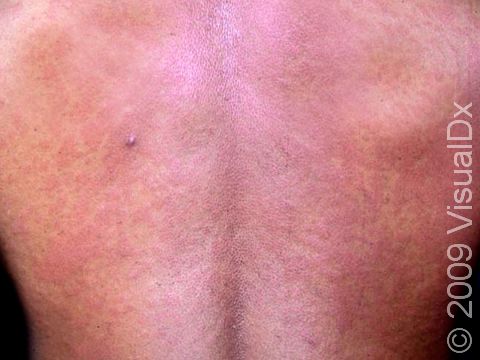Human Immunodeficiency Virus (HIV) Primary Infection
Primary human immunodeficiency virus (HIV) infection is an acute, flu-like illness that develops anywhere from 1-6 weeks following exposure to HIV. Chronic infection with this virus can cause acquired immunodeficiency syndrome (AIDS). The HIV virus destroys the body’s ability to fight infections and some cancers by progressively attacking and damaging the cells of the immune system. The most common way of becoming infected is through unprotected sex with an infected partner.
HIV is spread through exposure to the bodily fluids of an infected person through sex (vaginal, anal, or oral), blood exposure (through needle sharing, accidental blood exposure, blood transfusions, unsterilized medical equipment, or transplants), or from parent to child (during pregnancy, delivery, or through breastfeeding). The fluids must enter the body; ordinary skin contact and contact with sweat, tears, saliva, urine, or stool does not cause infection. There is no evidence that insect bites spread the virus.
You might see the first sign of infection (see Signs & Symptoms section) within 1-6 weeks after becoming infected, and signs may disappear within 1-4 weeks. HIV is often mistaken for other types of viral infection, so be sure to consult with your medical professional to confirm your diagnosis.
Who's At Risk?
More than a million Americans are infected with HIV, and a quarter of them may not know they are infected. Anyone can become infected, but in the United States, Black and Hispanic individuals are affected 7 and 3 times more often, respectively, than White individuals.
Other risk factors for acquiring HIV infection are:
- Having unprotected sex with multiple partners.
- Having unprotected sex with someone infected with HIV or whose infection status is unknown.
- Having another sexually transmitted infection, such as syphilis, gonorrhea, chlamydia, herpes, or bacterial vaginosis.
- Sharing drug needles or syringes.
- Being born to or breastfed by an untreated, infected individual.
Approximately half of individuals newly infected with HIV will have primary HIV infection syndrome, so see your medical professional promptly if you suspect you have signs of this condition.
Signs & Symptoms
A rash of small, pink-to-red spots primarily involving the trunk is seen in about half of people. People usually notice fever, swollen lymph nodes, headache, nausea, and/or diarrhea, as well as a sore throat. Other symptoms include vomiting, joint pain (arthralgias), and sensitivity to light (photophobia). Men may notice open sores (ulcers) in the mouth or on the penis.
Self-Care Guidelines
Even without symptoms, you can pass (transmit) the virus to others. People with primary HIV infection syndrome are 10 times more likely to transmit HIV than those who are in the chronic phase of HIV infection. If you think you might have been exposed to someone with HIV or if you have any of the known risk factors yourself (see the list under Who’s At Risk), avoid sexual activity, stop using needles to inject street drugs, and seek medical care and testing.
If you are infected:
- Find a competent medical professional who understands HIV.
- Eat healthy foods.
- Keep up to date with immunizations.
- Avoid smoking and illegal drug use.
- Get enough exercise and rest.
- Avoid other infections your immune system might have trouble fighting by washing your hands thoroughly and often, learning how to deal with pets and other animals, avoiding unpasteurized or raw foods, and drinking pure water.
If you choose to use any over-the-counter medicine or supplements, or alternative medicine practices such as acupuncture, be sure to let your medical professional know about them.
Treatments
Your medical professional will base the diagnosis on your symptoms and signs as well as the likelihood that you may be in a high-risk group, such as people who have multiple sex partners, use illicit intravenous drugs, or engage in unprotected or unsafe sex, especially men who have sex with men.
A blood test will be done to confirm the diagnosis; it may not show up as positive very early in the infection, so it may need to be repeated.
Any person with primary HIV infection should notify sexual partner(s) immediately. In most states, medical professionals are required by law to report HIV infections to the public health department.
Treatment is tailored for each person to make it as simple, effective, and with as few side effects as possible, and this often involves taking a mixture of medications, carefully overseen by a medical team. Newer treatments combine more than one medication within a single pill.
Visit Urgency
Anyone with flu-like symptoms and/or risk factors for HIV (see the list under Who’s At Risk) should avoid sexual activity, stop any nonmedical needle use, and seek medical care and testing.
Trusted Links
References
Bolognia J, Schaffer JV, Cerroni L. Dermatology. 4th ed. Philadelphia, PA: Elsevier; 2018.
James WD, Elston D, Treat JR, Rosenbach MA. Andrew’s Diseases of the Skin. 13th ed. Philadelphia, PA: Elsevier; 2019.
Kang S, Amagai M, Bruckner AL, et al. Fitzpatrick’s Dermatology. 9th ed. New York, NY: McGraw-Hill Education; 2019.
Paller A, Mancini A. Paller and Mancini: Hurwitz Clinical Pediatric Dermatology. 6th ed. St. Louis, MO: Elsevier; 2022.
Last modified on May 26th, 2023 at 3:22 pm

Not sure what to look for?
Try our new Rash and Skin Condition Finder
